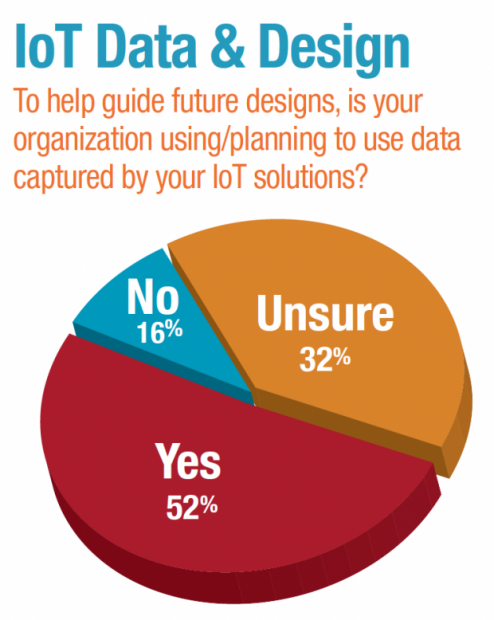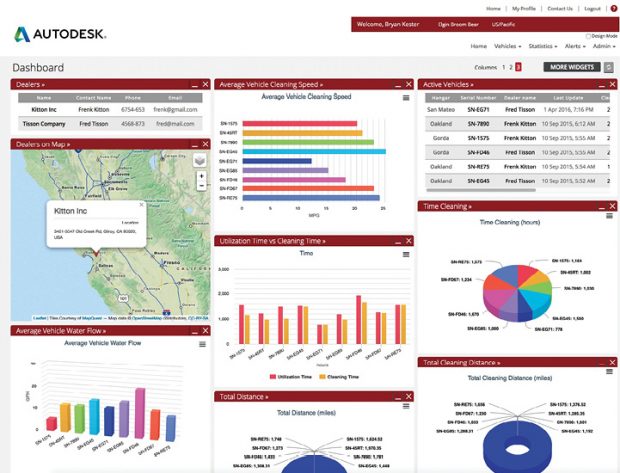IoT Analytics: More Hype Than Reality?

FusionConnect’s business intelligence-level analytics helps engineers make sense of IoT product data. Image courtesy of Autodesk.
Latest News
December 1, 2017
A new generation of internet of things (IoT) products and industrial assets is amassing stockpiles of data, but that treasure trove of potential insights has yet to drive product design processes in any meaningful way.
Many modern-day products, from smart appliances to industrial wind turbines, now regularly collect performance and usage data when in the field. These data reserves, combined with other relevant information, have the potential to serve up insights that could be tapped for basic monitoring of devices, predictive maintenance and eventually, self-healing service applications where products take action on their own to fix problems or recalibrate operations. Also in the mix is leveraging that same IoT data in the design process to address a specific flaw or to innovate completely new product offerings that better map to customer need.
Although there’s a lot of noise about how such IoT insights will revolutionize product design and service, the reality of what’s currently happening in mainstream engineering and service organizations is slightly more subdued. “We are somewhere between hype and reality,” notes Rob Patterson, vice president of strategic marketing for ThingWorx, at PTC. “What’s meaningful is we are starting to see a huge sea of data, but we’re not quite there yet in terms of realizing value from it. There’s still hype in the market that IoT is a magic box for delivering insights that solve everything, and that’s not the case at this point.”
The Analytics Progression
Although IoT activity may not live up to its hype, progress is being made and early milestones are being met. Gartner is forecasting that 8.4 billion connected things will be in use in 2017, up 31% from last year, and will reach 20.4 billion by 2020. Most of that activity is happening in the consumer segment, with 5.2 billion connected units (like smart TVs, cars and set-top boxes) this year, representing 63% of the overall application use cases, according to Gartner research. In comparison, businesses are on track to employ 3.1 billion connected things in 2017, mostly smart electric meters and commercial security cameras.
 Source: DE 2018 Technology Outlook Survey.
Source: DE 2018 Technology Outlook Survey.Xively, provider of an IoT platform for connected devices, sees a common progression for analytics use among its current customer base. Initially, customers leverage IoT data to monitor the health of products in the field, answering questions such as “is the device connected?” and “does it have the right firmware to operate properly?”—a scenario that is now quite mature, says Ryan Lester, Xively’s director of IoT strategy.
From there, companies spend time leveraging the data to get a real-time view of how customers are using products to understand what features they do or do not use or what they can do to make the product run better, including delivering feature updates via software, that is, the model being pioneered by Tesla. Over the years, Tesla has delivered “design updates” via software updates to fix a charger plug discovered to be a cause of fires, for example, and to optimize suspension settings for high speeds. “IoT provides a unique opportunity to start capitalizing on real-world usage data to help effectively iterate the design of a product primarily through software,” Lester explains.
Tapping IoT data for predictive analysis or failure analysis is the next frontier, particularly for high-end capital equipment like wind turbines or industrial equipment. Daimler Trucks North America has created a sensor-based predictive maintenance system that detects problems in trucks and alerts the dispatch centers of the need for service. PTC customer Sysmex, a maker of blood and urine analysis equipment, is leveraging the ThingWorx platform to service systems proactively and remotely, often issuing a fix via a software upgrade. Moving on from here, the ability to mix IoT data with third-party information such as supplier information to serve as a guide for product design changes is a future, but still elusive goal for most product designers.
“There aren’t a lot of line engineers adopting IoT to make products better—the service or sales organizations are adopting IoT to make the business better and customer relationships better, and the byproduct is that engineers make products better,” says Bryan Kester, director of IoT at Autodesk. Even so, Autodesk is starting to see a shift in that direction. Although a survey conducted last year found manufacturers connecting products to achieve competitive advantage (58%), develop new services or customers (52%) and to improve product uptime (49%), forthcoming research shows that design engineers are gaining interest in IoT as a tool for real-world product feedback over the next 24 months, Kester says.
 FusionConnect’s business intelligence-level analytics helps engineers make sense of IoT product data. Image courtesy of Autodesk.
FusionConnect’s business intelligence-level analytics helps engineers make sense of IoT product data. Image courtesy of Autodesk.“We’re finally at a point where design engineers seem to have valid reasons for experimenting with IoT,” says Kester, adding that the firm’s newly-released IoT Discovery Toolkit helps fast-track IoT product designs, including how to optimize data collection for future IoT analytics. Although product teams aren’t yet employing data to improve and iterate specific product designs, they have begun to employ IoT analytics to figure out how to segment a product line—for example, creating a family of air compressors fit for both indoors and ruggedized outdoor environments, explains Kester, citing one specific customer example. “That’s the primary usage with a lot of companies—figuring out how to segment products better in terms of how customers are actually using them,” he says.
28% of DE survey respondents strongly agreed or agreed that the IoT is more hype than real, which is the same as last year’s survey respondents.
Manufacturing customers of Autodesk, PTC and GE Digital are also ramping up IoT analytics efforts in areas like predictive maintenance and creating new services based on analysis of operational data collected in the field. Through analytics supercharged with machine learning capabilities, companies can examine real-time energy usage against energy market pricing, creating new value-added services that help customers run large assets like industrial machinery or compressors when it is more cost effective. In addition, using a digital twin (a 3D representation of an asset or product, including behavioral characteristics) as a baseline, companies can collect and analyze data from the physical products in the field to help uncover anomalies that suggest when a manufacturing asset is underperforming or when it requires maintenance.
“You can start to figure out those patterns quickly and understand the sources of error and failure on a fleet of manufacturing assets,” explains Chris Larkin, GE’s vice president of products and analytics, machine learning. Moving forward, Larkin says GE envisions a future where the IoT asset continually “learns” about its performance and failures in real time, able to make adjustments or automatically call out for servicing. “We believe the intelligent asset of the future is self-healing and self-adjusting,” he adds.
The Path to Success
One critical key to advancing IoT analytics is getting the data right—still a problem for many early adopters, according to Larkin. Part of the problem rests with sensors being situated properly or creating a high enough signal-to-noise ratio to produce meaningful data; other issues involve getting IoT data stored to the cloud in a secured way, pooling and structuring data, and integrating it with other key sources, including external resources or systems like ERP (enterprise resource planning), he says. “The biggest challenge isn’t finding talent or constructing algorithms—it’s organizations’ reluctance to put the crown jewels of manufacturing performance data and methods in the cloud,” Larkin says.
Many organizations have years of IoT data, but it’s not the right data to drive predictive maintenance projects or other IoT analytics efforts, explains Chad Boulanger, vice president of sales, analytics for Greenwave Systems, maker of the AXON IoT platform. One way Greenwave is trying to address the problem is by integrating AXON Predict, its IoT analytics tool, with VxWorks, a real-time operating system (RTOS). The solution, AXON Predict Analytics for VxWorks, enables analysis of real-time, high-volume streaming data at the edge, without having to connect to the cloud. “This lets you build analytics in as a first-class citizen when building a system,” notes John Crupi, Greenwave’s vice president of IoT analytics.
Another way to make insights from IoT analytics accessible to engineers is to deliver them into the systems already in use by product design teams. That’s the strategy many of the CAD and PLM (product lifecycle management) vendors are taking, including Siemens PLM Software and PTC. PTC’s Creo Product Insight Extension enables engineers to collect real-world product data from a test bed in the field, conduct trend analysis and leverage those insights to drive future generations of products or simply iterate an existing design. By doing so, engineers can validate design requirements with real-world data, not assumptions, and thus decrease reliance on physical prototyping, PTC’s Patterson says.
Siemens is now offering Product Intelligence for Teamcenter, a new SaaS-based big data analytics solution based on its Omneo acquisition. The tool melds data from a variety of sources, including design, procurement, supply chain and manufacturing with IoT field data and makes the insights available from within PLM, which organizations consider the system of record for engineering, says Bill Boswell, Siemens VP of marketing for the cloud services area and MindSphere, the company’s IoT platform.
“We’re trying to put the data analytics tools in the hands of the users themselves,” he explains. “This lets them do analytics in the same environment they are managing day-to-day design work in.”
Perhaps the most important order of business to enable engineering organizations to effectively capitalize on IoT insights: Creating a data-centric culture that makes insights just another step in a closed-loop design process. “IoT analytics let you gain insights into things you’re not able to do previously just by looking at small samples of products in the field,” Patterson says. “This lets you get more accurate feedback from an overall product population. That means engineers have to become more data centric to the overall population of devices not just design centric for evolving a product.”
More Info
Subscribe to our FREE magazine, FREE email newsletters or both!
Latest News
About the Author
Beth Stackpole is a contributing editor to Digital Engineering. Send e-mail about this article to [email protected].
Follow DE





